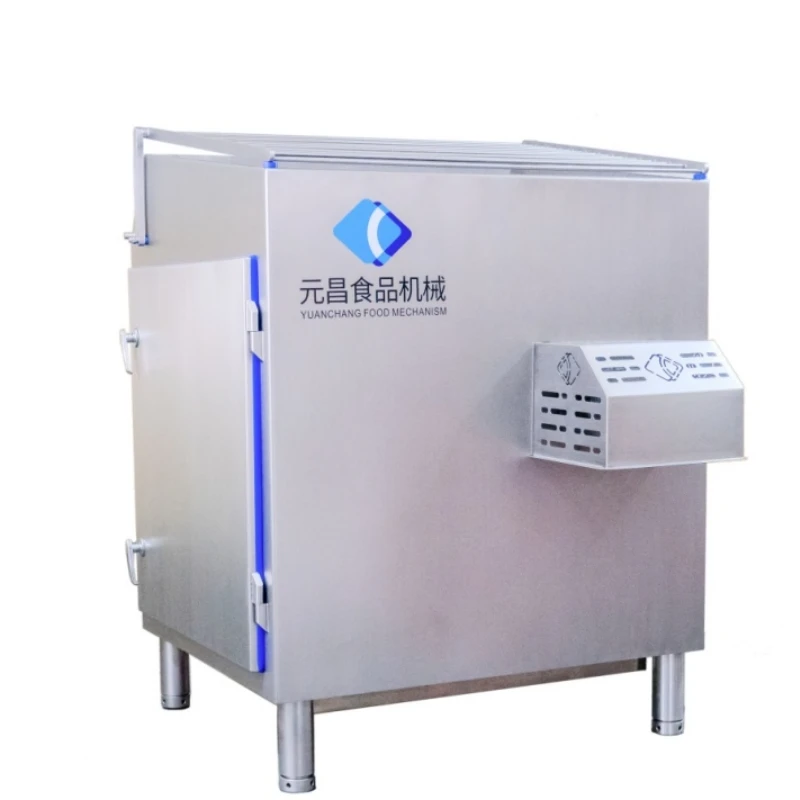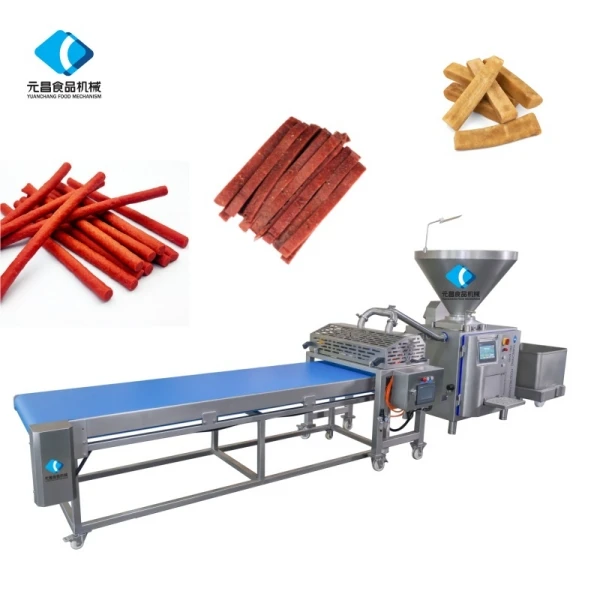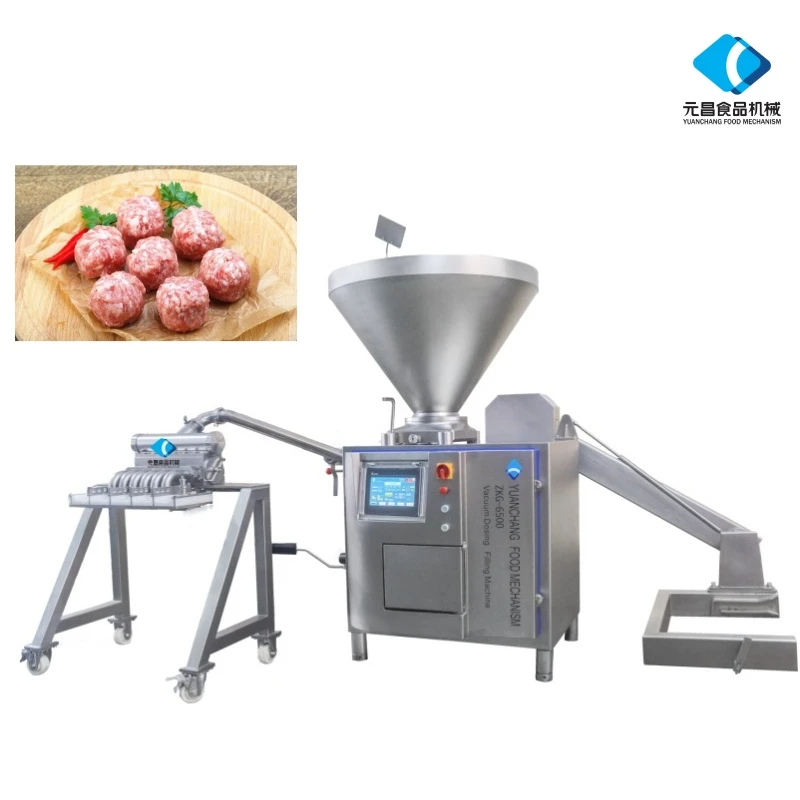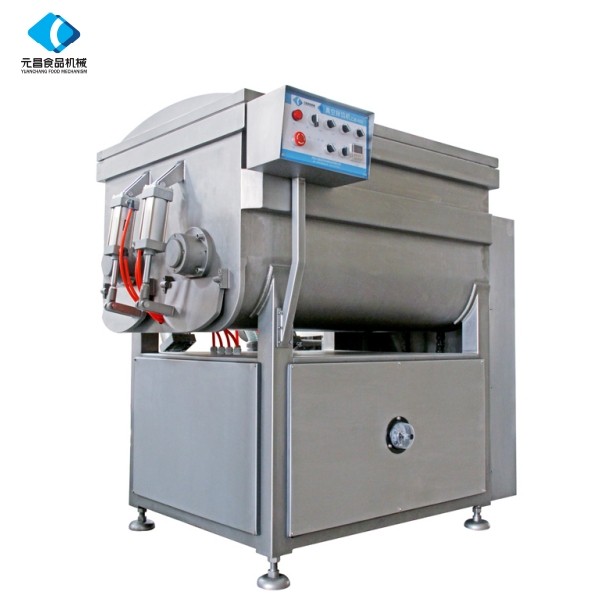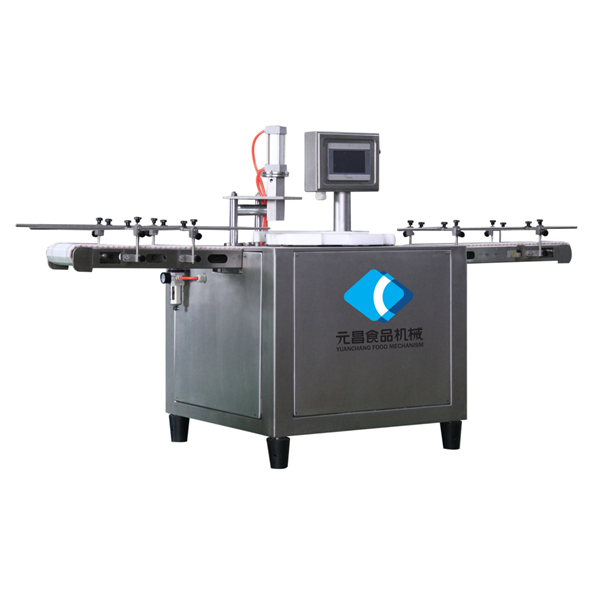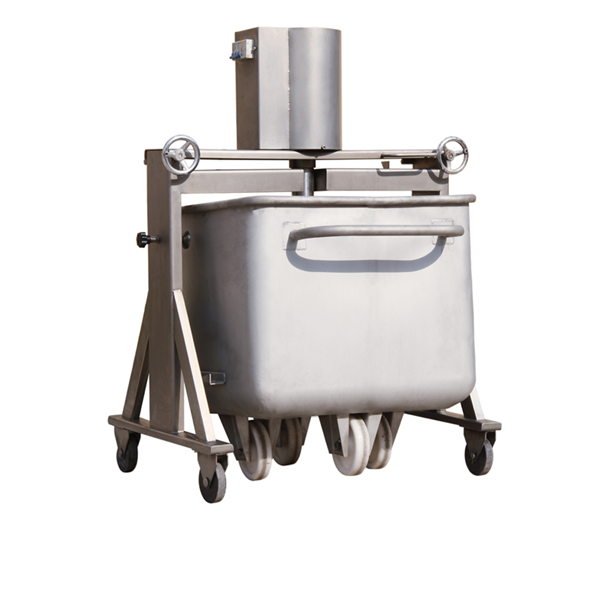High-Speed Sausage Twist Linker | Automatic Precision Linking
The Pivotal Role of sausage twist linker in Modern Meat Processing
In the rapidly evolving landscape of meat processing, efficiency, hygiene, and product consistency are paramount. The sausage twist linker stands as a cornerstone technology, enabling high-volume production of precisely portioned and twisted sausages. This specialized machinery, often integrated within a comprehensive sausage production line, automates a critical step that traditionally required extensive manual labor, thereby enhancing operational throughput, reducing human error, and ensuring superior product presentation. Modern food processing facilities demand equipment that not only performs reliably but also adheres to stringent sanitary standards and offers advanced control capabilities. Our focus herein is to delve into the technical intricacies, application versatility, and strategic advantages offered by advanced sausage twisting solutions, providing decision-makers with a comprehensive understanding of their vital role.
Current Industry Trends in Sausage Production Automation
The global meat processing industry is undergoing significant transformation, driven by consumer demand for convenience, safety, and diverse product offerings. Key trends influencing the development and adoption of technologies like the sausage twist linker include:
- Increased Automation and Robotics: To combat rising labor costs and ensure consistent quality, processors are investing heavily in automated systems. This includes advanced sausage twisting machines that can operate at high speeds with minimal human intervention.
- Enhanced Food Safety and Hygiene: Stricter regulatory requirements (e.g., HACCP, FDA) necessitate machinery designed for easy cleaning, made from food-grade materials (e.g., SUS304/316L stainless steel), and featuring sealed components to prevent contamination.
- Data-Driven Production and IoT Integration: Modern equipment is increasingly equipped with sensors and connectivity for real-time monitoring, predictive maintenance, and optimization of production parameters. This allows for better control over the entire process, from a sausage filler machine to final packaging.
- Flexibility and Customization: Producers need machines that can handle a variety of casing types (natural, collagen, cellulose) and calibers, as well as different product formulations, to cater to diverse market demands.
- Sustainability and Energy Efficiency: The drive for reduced energy consumption and waste is prompting manufacturers to develop more efficient motors (e.g., servo drives) and optimized operational protocols.
These trends underscore the importance of robust, intelligent, and adaptable equipment in maintaining competitiveness and meeting consumer expectations in the global food market.
Manufacturing Process Flow of an Advanced Sausage Twisting System
The manufacturing of a high-performance sausage twist linker involves a meticulous multi-stage process, ensuring durability, precision, and adherence to food-grade standards. This process ensures the finished machinery can withstand the rigorous demands of continuous industrial operation while maintaining the highest levels of hygiene.
I. Materials Selection & Sourcing
Food-Grade Stainless Steel (SUS304/SUS316L):
- • Component Focus: All parts in contact with meat products, machine frame, and external surfaces.
- • Properties: Excellent corrosion resistance, hygienic surface finish, non-reactive with food, easy to clean.
High-Performance Engineering Plastics (e.g., UHMW-PE, PTFE):
- • Component Focus: Guides, seals, certain conveyor elements.
- • Properties: Low friction, wear resistance, food-safe, chemical inertness.
Precision Electrical and Electronic Components:
- • Component Focus: Servo motors, PLCs, HMI touchscreens, sensors, wiring.
- • Properties: Reliability, accuracy, industrial-grade durability, often IP65/IP67 rated.
II. Fabrication & Machining Processes
CNC Machining:
- • Application: Creation of complex parts with high precision (e.g., twisting nozzles, gear components, custom fittings).
- • Advantage: Ensures tight tolerances, critical for consistent twisting and long-term mechanical reliability.
Laser Cutting & Bending:
- • Application: Fabrication of machine frames, panels, and enclosures from stainless steel sheets.
- • Advantage: Provides clean cuts and accurate bends, crucial for aesthetic and structural integrity, and ease of sanitation.
Welding (TIG/MIG):
- • Application: Joining stainless steel components to form robust, seamless structures.
- • Advantage: Ensures strength and eliminates crevices where bacteria could harbor, vital for food safety. Post-weld passivation is often performed to restore corrosion resistance.
III. Assembly & Integration
Mechanical Assembly:
- • Precision fitting of all fabricated parts, bearings, gears, and pneumatic components.
Electrical & Control System Integration:
- • Installation and wiring of PLC, HMI, servo drives, motors, and sensors. Programming of machine logic and user interface.
IV. Testing & Quality Assurance
Functional & Performance Testing:
- • Verification of twisting speed, portion accuracy, sealing integrity, and overall machine throughput against design specifications.
Hygiene & Material Compliance:
- • Adherence to international standards like ISO 22000 for food safety management systems, FDA guidelines for food contact materials, and CE marking for European market access.
- • Testing for surface roughness to ensure ease of cleaning and sanitation.
Durability & Service Life Testing:
- • Accelerated life cycle testing to ensure components meet projected service life expectations (typically 10-15 years with proper maintenance for core mechanical parts).
Target industries benefiting from such meticulously engineered sausage twist linker systems primarily include:
- Large-Scale Meat Processing Plants: Requiring high throughput and consistent product quality for mass distribution.
- Specialty Sausage Producers: Needing precision for artisanal or premium products, often with delicate casings.
- Ready-Meal Manufacturers: Integrating sausages into complex food preparations, demanding precise portioning.
- Food Service Suppliers: Catering to restaurants and institutional kitchens with pre-portioned, high-quality sausage products.
Advantages in typical application scenarios include significant energy saving due to advanced servo motor technology, superior corrosion resistance from high-grade stainless steel construction, and simplified maintenance procedures that reduce downtime.

Technical Specifications of a Leading Sausage Twist Linker
Understanding the technical specifications is crucial for evaluating the suitability of a sausage twist linker for specific production needs. Modern machines integrate advanced controls and robust mechanics to deliver unparalleled performance.
Key Parameters:
| Parameter | Specification | Description/Benefit |
|---|---|---|
| Production Capacity | Up to 1000 portions/min | High throughput for industrial-scale operations. |
| Portion Weight Accuracy | ±0.5g deviation (typical) | Minimizes product giveaway and ensures consistent product sizing. |
| Casing Diameter Range | 13mm - 40mm | Versatility for various sausage types (e.g., frankfurters, breakfast sausages). |
| Twist Length Adjustment | 25mm - 200mm (HMI configurable) | Allows for diverse product lengths without mechanical changes. |
| Control System | Siemens/Allen-Bradley PLC, HMI Touchscreen | User-friendly operation, precise control, diagnostic capabilities. |
| Drive System | Independent Servo Motors | Energy efficient, high torque, precise speed and position control. |
| Material Construction | SUS304 / SUS316L Stainless Steel | Ensures hygiene, corrosion resistance, and longevity. |
| Power Requirement | 3 Phase, 380V/50Hz, 5kW | Standard industrial power, optimized for energy consumption. |
| Protection Rating | IP65 | Resistant to dust and low-pressure water jets, suitable for washdown environments. |
These specifications demonstrate the advanced engineering behind modern sausage twist linker systems. The use of servo motors for instance provides dynamic control over twisting parameters, minimizing stress on casings and ensuring consistent product aesthetics. The IP65 rating signifies the machine's suitability for rigorous cleaning protocols, a non-negotiable in food processing. Precision at every stage, from filling to linking, is critical for operational success and compliance.
Application Scenarios Across the Meat Processing Industry
The versatility of the sausage twist linker allows its integration into diverse production lines, addressing various product requirements and operational scales. Its primary function is to create individual sausages of uniform length and weight by twisting the casing filled by a sausage filler machine.
- High-Volume Fresh Sausage Production: In facilities producing breakfast sausages, frankfurters, or Italian sausages for retail, the twist linker ensures rapid, continuous production with consistent portioning. This integrates seamlessly with an upstream sausage filler machine and potentially a downstream sausage cutting machine or hanging system.
- Cured and Smoked Sausage Lines: For products like bratwurst, chorizo, or salami, precise linking is vital before the curing, smoking, or cooking stages. The gentle twisting action preserves casing integrity.
- Specialty and Artisanal Sausage Manufacturing: Even smaller operations benefit from the precision, especially when working with delicate natural casings or unique product formulations where portion control is critical for brand identity.
- Integrated Production Systems: The sausage twisting machine is often a core component of fully automated lines that include filling, twisting, hanging, and then an automatic sausage clipper machine or cutter for further processing.
Such integration capabilities enable processors to maximize efficiency, reduce manual handling, and ensure a continuous flow from raw ingredients to finished, packaged products. The flexibility to handle various casing materials (collagen, natural, cellulose, alginate) and diameters further expands its utility across a broad spectrum of sausage products.

Technical Advantages of Advanced Sausage Twist Linker Systems
Investing in a high-quality sausage twist linker offers a multitude of technical and operational advantages that significantly impact a processing plant's bottom line and product quality:
- Unmatched Portioning Accuracy: Servo-driven twist mechanisms, synchronized with advanced sausage filler machines, ensure consistent sausage length and weight. This precision minimizes giveaway, leading to substantial raw material savings over time. Data from a 2022 industry report suggests that advanced portioning can reduce raw material waste by 1-3% in high-volume operations.
- High Operational Speed and Throughput: Modern machines can achieve speeds of up to 1000 portions per minute, dramatically increasing production capacity compared to manual or older semi-automatic systems. This translates to higher output per shift and lower cost per unit.
- Superior Hygienic Design: Constructed from AISI 304 or 316L stainless steel, with smooth surfaces, minimal crevices, and quick-release components, these machines facilitate thorough cleaning and sanitation. This significantly reduces the risk of bacterial contamination and ensures compliance with HACCP and FDA standards.
- Versatility in Casing Handling: Advanced tension control systems and adjustable nozzles allow for seamless processing of various casing types—natural, collagen, cellulose, and even alginate—across a wide range of diameters without significant retooling.
- Reduced Labor Dependency: Automation of the twisting and linking process significantly reduces the need for skilled manual labor, mitigating labor shortage challenges and reducing operational costs. One machine can replace multiple operators, allowing staff to be redeployed to other critical tasks.
- Enhanced Product Quality and Aesthetics: Consistent twists and portions contribute to a uniform product appearance, enhancing market appeal and brand perception. The gentle twisting mechanism also minimizes casing breakage and product damage.
- Advanced Control and Diagnostics: PLC-based control systems with intuitive HMI touchscreens offer precise parameter adjustments, recipe management, and real-time diagnostics. This simplifies operation, enables quick changeovers, and facilitates troubleshooting, minimizing downtime.
- Energy Efficiency: Implementation of high-efficiency servo motors and optimized power management systems results in lower energy consumption compared to older hydraulic or pneumatic systems, contributing to lower operating expenses and a reduced environmental footprint.
These advantages collectively position advanced sausage twist linker systems as critical investments for any meat processor aiming for peak efficiency, consistent quality, and sustained growth.
Vendor Comparison: Choosing the Right Sausage Twist Linker Partner
Selecting the appropriate vendor for a sausage twist linker involves more than just comparing technical specifications. It requires a holistic evaluation of product quality, service, innovation, and long-term partnership potential. Below is a conceptual comparison matrix to guide your decision-making.
Comparison Factors:
| Feature/Factor | Premium Vendor (e.g., YC Meat Mech) | Mid-Range Vendor | Budget Vendor |
|---|---|---|---|
| Technology & Innovation | Latest servo drives, advanced PLC, IoT-ready, continuous R&D. | Modern PLC, robust mechanics, some automation features. | Basic automation, older control systems, simpler mechanics. |
| Material Quality & Hygiene | Full SUS304/316L, IP65/67, excellent surface finish, hygienic design for easy washdown. Certified to ISO, HACCP, FDA standards. | Mostly SUS304, good finish, adequate IP rating (IP55/65). | Mixed materials, basic IP rating, may have more difficult-to-clean areas. |
| Performance (Speed & Accuracy) | High speed (>800 portions/min), superior portion weight consistency (±0.5g). | Good speed (400-600 portions/min), acceptable accuracy (±1g). | Moderate speed (<400 portions/min), variable accuracy. |
| Customization Options | Extensive (casing types, production line integration, specialized nozzles). | Moderate (some nozzle changes, basic integration). | Limited or none (standard models only). |
| After-Sales Support | Global service network, 24/7 technical support, remote diagnostics, extensive spare parts inventory, comprehensive training. | Regional support, standard business hours, essential spare parts. | Limited support, slower response, basic spare parts. |
| Warranty & Lead Time | 2-3 year comprehensive warranty, 8-12 week lead time (customizable). | 1-year standard warranty, 10-16 week lead time. | Limited warranty, longer lead times (12-20+ weeks). |
| Total Cost of Ownership (TCO) | Higher initial investment, but lower long-term costs due to efficiency, durability, and minimal downtime. | Balanced initial cost and TCO. | Lower initial investment, but potentially higher TCO due to maintenance, repairs, and lost productivity. |
Choosing a premium vendor like YC Meat Mech, with decades of experience in the meat machinery sector, ensures access to cutting-edge technology, robust build quality, and comprehensive after-sales support. Their commitment to innovation and adherence to international standards like ISO 9001 and CE certification provide a solid foundation for long-term operational success and compliance. Partner clients globally attest to the reliability and performance of their sausage twisting machine solutions.
Customized Solutions for Unique Production Demands
Recognizing that no two meat processing facilities are identical, leading manufacturers offer bespoke sausage twist linker solutions tailored to specific operational requirements. Customization ensures optimal integration with existing infrastructure, maximizes efficiency for unique product portfolios, and addresses particular space or logistical constraints.
- Casing and Product Specific Adaptations: This includes custom-designed twisting nozzles, horn diameters, and tensioning systems optimized for challenging casings (e.g., very thin natural casings, extra-large diameter cellulose casings) or specialized product consistencies.
- Integration with Existing Lines: Seamless interface design to integrate the sausage twist linker with upstream sausage filler machines and downstream equipment such as smokehouse loading systems, automatic sausage clippers, or packaging lines. This may involve custom conveyor systems or synchronized control protocols.
- Software and Recipe Management: Tailored HMI interfaces with expanded recipe storage, advanced reporting features, and integration with plant-wide SCADA or MES systems for centralized control and data analysis.
- Space Optimization and Layout: Design modifications to fit machines into challenging footprints, including compact versions or configurations that allow for specific in-plant logistics, such as side-feeding or elevated installations.
- Regional Compliance and Utility Requirements: Adapting electrical specifications, safety features, and language support to meet local regulatory standards (e.g., USDA, CSA, EAC) and available utility supplies.
A dedicated team of engineers works closely with clients to assess their needs, conduct feasibility studies, and develop CAD designs, ensuring the customized solution delivers maximum performance and return on investment. This consultative approach is a hallmark of authoritative vendors committed to long-term client success.
Application Case Studies & Customer Successes
Real-world application demonstrates the transformative impact of advanced sausage twist linker technology on production efficiency and product quality. Here are illustrative examples:
Case Study 1: Large-Scale Frankfurters Manufacturer
- • Client Profile: A major European meat processor specializing in high-volume production of skinless frankfurters and hot dogs.
- • Challenge: Their existing clipping machines struggled with speed and portion consistency, leading to significant product giveaway and bottlenecks in the production line.
- • Solution: Integrated an advanced sausage twist linker with a synchronous hanging line. The machine was configured for 21mm collagen casings and an output of 850 portions/minute.
- • Outcome: Achieved a 25% increase in production throughput and a 1.5% reduction in raw material waste due to improved portion accuracy. The customer reported, "The consistency and speed of the new linker have revolutionized our frankfurter line, significantly boosting our profitability."
Case Study 2: Specialty Charcuterie Producer
- • Client Profile: A regional producer of high-end artisanal sausages and cured meats, utilizing natural hog and sheep casings.
- • Challenge: Manual twisting was labor-intensive, inconsistent, and often resulted in casing damage with delicate natural casings. They needed precision for premium pricing.
- • Solution: Deployed a customized sausage twist linker with specialized, gentle twisting nozzles and fine-tuned tension control, capable of handling casings from 24mm to 36mm.
- • Outcome: Reduced casing breakage by 80% and achieved perfectly uniform twists, enhancing the premium aesthetic of their products. Labor costs associated with twisting were cut by 70%. Customer feedback highlighted, "The machine maintains the artisanal quality we pride ourselves on, but at a scale and consistency we couldn't achieve manually."

Frequently Asked Questions (FAQ)
- Q: What is the typical service life of a sausage twist linker?
- A: With proper maintenance and regular servicing, a high-quality sausage twist linker is designed for a service life of 10-15 years or more. Key components are built for continuous industrial operation.
- Q: Can the machine handle both natural and artificial casings?
- A: Yes, advanced models are highly versatile and can process a wide range of casing types including natural, collagen, cellulose, and plastic casings. Specific nozzles and tension settings are often adjustable via the HMI.
- Q: How easy is it to clean and maintain the equipment?
- A: Modern sausage twist linkers are designed with hygiene in mind. They feature smooth stainless steel surfaces, minimal crevices, and quick-release components for easy disassembly and thorough washdown, adhering to IP65/IP67 standards.
- Q: What kind of training is provided for operators?
- A: Reputable manufacturers offer comprehensive on-site training for operators and maintenance staff, covering machine operation, programming, routine cleaning, and basic troubleshooting.
- Q: Is remote support available for diagnostics and troubleshooting?
- A: Many advanced systems include remote access capabilities, allowing technical support teams to diagnose issues, update software, and provide guidance without requiring an on-site visit, minimizing downtime.
Logistics, Warranty, and Support Information
Investing in industrial machinery requires a clear understanding of the logistics, warranty, and support infrastructure that underpins the product. YC Meat Mech, as a leading provider, offers comprehensive services to ensure client satisfaction and operational continuity.
Lead Time & Fulfillment:
- Standard Models: Typically 8-12 weeks from order confirmation to shipment, depending on current production schedules.
- Customized Solutions: Lead times for bespoke sausage twist linker systems may range from 12-20 weeks, subject to complexity and component availability.
- Logistics: We facilitate global shipping via trusted freight partners, managing customs documentation and ensuring secure transit.
Warranty Commitments:
- Standard Warranty: All YC Meat Mech sausage twist linker machines come with a comprehensive 2-year warranty on parts and manufacturing defects.
- Extended Warranty: Options for extended warranty packages are available upon request, offering peace of mind beyond the standard period.
- Coverage: Warranty covers defects in material and workmanship under normal use and service. Exclusions typically include consumable parts and damage due to misuse or improper maintenance.
Customer Support & After-Sales Service:
- Technical Support: Dedicated 24/7 technical hotline and email support for immediate assistance with operational queries or minor troubleshooting.
- Spare Parts Management: Extensive global inventory of genuine spare parts ensures rapid delivery and minimal downtime. Critical wear parts are readily available.
- Preventative Maintenance Programs: Tailored service contracts are offered to ensure optimal machine performance, extend equipment life, and reduce the risk of unexpected breakdowns.
- On-Site Service: A network of experienced field technicians provides installation, commissioning, training, and repair services globally.
Our commitment to robust support ensures that your investment in a YC Meat Mech sausage twist linker continues to deliver value throughout its operational lifespan.
Conclusion
The modern sausage twist linker is far more than a simple piece of equipment; it is a sophisticated engineering solution critical to the efficiency, hygiene, and profitability of contemporary meat processing operations. As the industry continues to advance, the demand for high-speed, accurate, and adaptable twisting solutions will only grow. By understanding the intricate manufacturing processes, technical advantages, and comprehensive support systems, food processors can make informed decisions to optimize their production lines, enhance product quality, and achieve sustainable growth in a competitive global market.
References
- Food and Drug Administration (FDA). (2023). Guidance for Industry: Food-Grade Materials in Food Processing. FDA.gov.
- International Organization for Standardization (ISO). (2022). ISO 22000: Food Safety Management Systems – Requirements for any organization in the food chain. ISO.org.
- Meat & Poultry Magazine. (2022). Annual Report on Meat Processing Automation Trends. Meatingplace.com.
- The National Academies Press. (2019). Enhancing Food Safety: The Role of the Food Processing Industry. NAP.edu.
- European Hygienic Engineering & Design Group (EHEDG). (2021). Hygienic Design of Food Processing Equipment: Principles and Guidelines. EHEDG.org.
-
Discover the Benefits of Vacuum Marinating Machines for Efficient Food ProcessingNewsNov.24,2025
-
The Ultimate Guide to Commercial Chicken Scalders: Efficiency, Sustainability & InnovationNewsNov.23,2025
-
Chicken Harvesting Equipment: Efficient & Humane Solutions for Poultry ProducersNewsNov.22,2025
-
Comprehensive Guide to Meat Processing Plant Equipment | Efficiency, Safety & SustainabilityNewsNov.21,2025
-
Meat Processing Bins: Durable Solutions for Safe & Efficient Meat Handling WorldwideNewsNov.20,2025
-
Best Commercial Marinating Machines for Meat Processing | Efficient & ScalableNewsNov.20,2025



